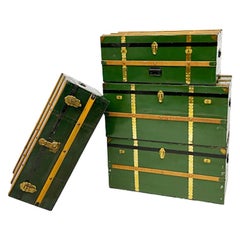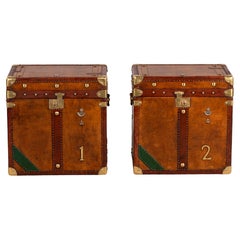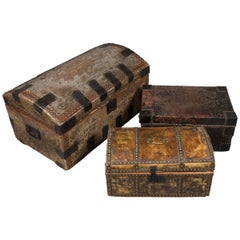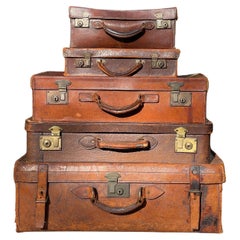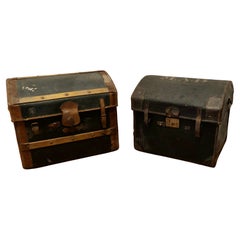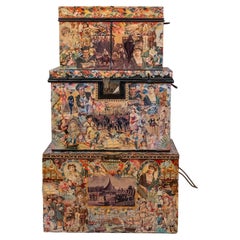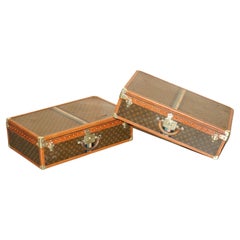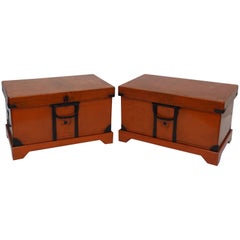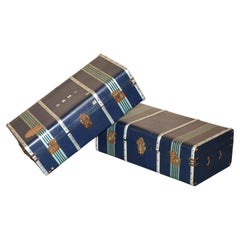Antique Furniture Trunks
Early 20th Century Dutch Antique Furniture Trunks
Metal, Copper
Early 20th Century English Antique Furniture Trunks
Brass
1840s American Antique Furniture Trunks
Leather
19th Century American Classical Antique Furniture Trunks
Metal
Late 19th Century Victorian Antique Furniture Trunks
Wicker
Early 20th Century American Victorian Antique Furniture Trunks
Metal
1910s French Edwardian Antique Furniture Trunks
Brass
Late 19th Century Japanese Edo Antique Furniture Trunks
Iron
1920s English Art Deco Antique Furniture Trunks
Aluminum, Iron, Steel
Early 20th Century Antique Furniture Trunks
Metal, Brass
Early 20th Century French Antique Furniture Trunks
Brass
Early 20th Century French Antique Furniture Trunks
Brass
1910s French Antique Furniture Trunks
Brass
Early 20th Century French Antique Furniture Trunks
Brass
Early 20th Century French Antique Furniture Trunks
Brass, Steel
1920s French Antique Furniture Trunks
Brass
19th Century English Campaign Antique Furniture Trunks
Metal, Brass
Early 19th Century Chinese Minimalist Antique Furniture Trunks
Brass
19th Century English Campaign Antique Furniture Trunks
Metal, Brass
Early 20th Century French Antique Furniture Trunks
Brass
1830s French Antique Furniture Trunks
Brass
Late 19th Century French Antique Furniture Trunks
Brass
Early 20th Century French Antique Furniture Trunks
Leather
Late 19th Century French Antique Furniture Trunks
Brass
Early 20th Century French Antique Furniture Trunks
Brass
1870s Hungarian High Victorian Antique Furniture Trunks
Pine
Early 1900s French Other Antique Furniture Trunks
Brass
1910s French Other Antique Furniture Trunks
Brass
19th Century English Art Nouveau Antique Furniture Trunks
Copper
1870s European High Victorian Antique Furniture Trunks
Pine
Early 19th Century Chinese Qing Antique Furniture Trunks
Brass
1910s French Other Antique Furniture Trunks
Brass
1910s French Other Antique Furniture Trunks
Leather, Canvas, Wood
1910s French Other Antique Furniture Trunks
Leather, Canvas, Wood
18th Century Spanish Neoclassical Antique Furniture Trunks
Other
1880s British Indian Ocean Territory Campaign Antique Furniture Trunks
Leather, Fruitwood
Early 20th Century French Antique Furniture Trunks
Brass
19th Century English Victorian Antique Furniture Trunks
Oak
1920s Chinese Antique Furniture Trunks
Wood
Late 19th Century Unknown Chinese Export Antique Furniture Trunks
Wood
Early 1900s European Late Victorian Antique Furniture Trunks
Pine
17th Century French Antique Furniture Trunks
Brass
18th Century German Baroque Antique Furniture Trunks
Iron
Early 1900s Romanian Late Victorian Antique Furniture Trunks
Pine
1880s Romanian High Victorian Antique Furniture Trunks
Pine
1880s European High Victorian Antique Furniture Trunks
Pine
Early 1900s European High Victorian Antique Furniture Trunks
Pine
Early 1800s European George III Antique Furniture Trunks
Pine
Early 1800s European George III Antique Furniture Trunks
Pine
Early 1900s European Edwardian Antique Furniture Trunks
Pine
Early 1800s European George III Antique Furniture Trunks
Pine
19th Century French Antique Furniture Trunks
Metal, Brass
Early 20th Century English Edwardian Antique Furniture Trunks
Brass
19th Century French Other Antique Furniture Trunks
Iron
1920s French Art Deco Antique Furniture Trunks
Canvas
19th Century French Regency Antique Furniture Trunks
Vermeil
Early 20th Century American American Empire Antique Furniture Trunks
Brass
Late 19th Century Indian Anglo-Indian Antique Furniture Trunks
Brass
Early 20th Century French Antique Furniture Trunks
Leather
1880s Slovak Antique Furniture Trunks
Brass
- 1
- ...
Antique Furniture Trunks For Sale on 1stDibs
Finding the Right Trunks-luggage for You
Add a charming piece of travel history to your space. Antique and vintage trunks and luggage can make a statement as decorative accents and practical furnishings in nearly every room of your home.
There have been many types of trunks and luggage over the years, with availability of these wares broadening as train travel expanded during the 19th century. Antique steamer trunks — named for their use on steamships — mostly date from around 1880 to 1920. These pieces of luggage fit a steamship’s luggage size regulations and essentially doubled as wardrobes, ensuring that a traveler’s evening dresses and suits were kept wrinkle-free on a journey from city to city.
In 1858, French luxury brand Louis Vuitton introduced the world to the now-iconic Louis Vuitton trunks. During this early period of railroad travel, Louis Vuitton trunks solved common travel problems. Instead of the traditional round shape, these handcrafted rectangular trunks stored better on trains. To discourage burglars, the French craftsman and his son, Georges, also eventually patented a revolutionary sophisticated lock for the trunks. The famous LV monogram was first used in 1896 as part of an initiative by Georges to prevent counterfeiting of his coveted travel trunks.
Even if no longer used for travel, the vintage luggage is a popular item among collectors for its historical value and charm. At home, an old wood trunk is a durable storage solution as much as it is a versatile surface. It’s a coffee table in the living room of your farmhouse-style home or rustic loft apartment and a nightstand or blanket chest at the foot of your bed in your bedroom.
From Victorian trunks to Art Deco traveling jewelry cases, journey through history today with an extensive collection of antique trunk suitcases and vintage luggage on 1stDibs.
- Is antique furniture in style?1 Answer1stDibs ExpertApril 22, 2024Yes, antique furniture is in style. Many people appreciate the beauty and handcrafted character of antique furniture and love the idea of owning pieces with a rich history. Remember that style preferences are nothing if not fluid, meaning what's in one year may not be the next. So, in choosing the furniture you're planning to live with, you should pay less attention to interior design fads than to what speaks to you. That way, you can select pieces that will add long-term character to your home. On 1stDibs, find a large collection of antique furniture.
- 1stDibs ExpertMay 30, 2024To identify your antique furniture, look for an engraving, tag, label or other marking that indicates who produced it. You may find it on the bottom or back of your furniture or inside a drawer or cabinet. Once you have located the marking, you can snap a photo of it and use a reverse image search to try and identify the maker. Or, you can type a description of the mark into a search engine. Alternatively, you can use the services of a certified appraiser or antiques dealer to get assistance with identification. On 1stDibs, shop a large selection of antique furniture.
- What makes furniture an antique?1 Answer1stDibs ExpertAugust 15, 2019
A piece of furniture is considered an antique if it is at least 100 years old.
- 1stDibs ExpertApril 5, 2024To know if your furniture is antique, look for labels and markings that indicate the maker. From there, you can use trusted online resources to determine when they were active and examine images to try to estimate the age of your piece. Furniture produced 100 years ago or more is antique. You can also have your furniture assessed by an appraiser or antiques dealer to learn about its age. On 1stDibs, explore a large collection of antique furniture.
- 1stDibs ExpertMay 14, 2024Many antique furniture brands are popular. While trends in collecting do vary over time, some makers consistently remain highly sought after. Among them are J. & J.W. Meeks, John Henry Belter, R. J. Horner and Co., Stickley Furniture, George Hepplewhite, Josef Dannhauser, Thomas Chippendale and Thomas Sheridan. On 1stDibs, shop a variety of antique furniture.
- 1stDibs ExpertFebruary 22, 2021Antique furniture can be worth quite a lot, particularly if it is in good quality. The rarer the piece, the higher the value.
- 1stDibs ExpertFebruary 13, 2024Whether antique furniture is making a comeback is a matter of opinion. Many people would argue that antique furniture never faded from fashion, as there have always been individuals who love the idea of owning pieces that have history. Some of the most popular styles for antique furniture include Art Deco, Arts and Crafts, Renaissance Revival, Elizabethan, Gothic Revival, Victorian and Chippendale. Find a large collection of antique furniture from some of the world's top dealers on 1stDibs.
- 1stDibs ExpertFebruary 1, 2024To date antique furniture from the UK, first look for identifying markings on the piece. You can then use trusted online resources to determine when the maker was active. From there, you may be able to estimate the year of production by looking at images of other furniture the maker produced. An expert appraiser or antiques dealer can also aid you in the dating process. Find a large selection of antique furniture on 1stDibs.
- 1stDibs ExpertFebruary 22, 2021There are a number of factors that can indicate if your antique furniture is valuable. When determining the value of antique furniture, consider its rarity. Additionally, it is important to determine the quality and condition of vintage furniture. If unsure of the value of your vintage furniture, have it appraised.
- 1stDibs ExpertOctober 24, 2024To tell who made your antique furniture, seek out a maker's marking. Locations of these marks vary, but they are generally in an inconspicuous location. For example, a dresser may have the mark inside a drawer or on the back, while a hallmark on a table is often on a leg or under the tabletop. Once you locate a mark, you can use trusted online resources to identify the maker and learn more about them. If you can't find a marking on your piece, a certified appraiser or knowledgeable antique dealer can assist you with the identification process. Explore a large selection of antique furniture on 1stDibs.
- 1stDibs ExpertOctober 24, 2024To tell antique furniture from reproduction, first check for a maker's mark. By researching the maker associated with the marking using trusted online resources, you can determine when they were active. If the company was in business 100 years ago or more, your piece may be an antique, but if the company's history began more recently, your piece is likely a reproduction. If you can't locate a marking, study the details of the furniture up close. Genuine antiques will often show tool marks and slight variations in carved details because they were typically handcrafted. Most contemporary furniture is machine-made, so you won't usually see these types of characteristics. When in doubt, have a certified appraiser or knowledgeable antique dealer evaluate your furniture. On 1stDibs, find a wide variety of antique furniture.
- 1stDibs ExpertNovember 4, 2024To identify antique Chinese furniture, look carefully at its details. Chinese craftsmen often built furniture using mortise and tenon joinery, eliminating the need for nails and screws. If you see this type of hardware, your piece is likely not at least 100 years old, especially if the hardware still looks new and shiny. Since antique furniture was handmade, you will normally see slight imperfections, such as tool marks or slight variations in carvings. Pieces that appear completely uniform and pristine are less often genuine antiques.
When present, maker's marks can also be helpful. Research the marks to learn more about when the maker was active and producing pieces like yours. Alternatively, you can have a certified appraiser or experienced antique dealer evaluate your furniture for you.
Shop an assortment of antique Chinese furniture. - 1stDibs ExpertNovember 13, 2024How old furniture that is called antique can be is typically at least 100 years. People usually call furniture between 20 and 99 years old vintage. Contemporary is the word for furniture manufactured within the last 20 years. On 1stDibs, shop a large selection of antique, vintage and contemporary furniture from some of the world's top sellers.
- 1stDibs ExpertOctober 5, 2021The best finish for antique furniture is a matter of liking. But film finish is recommended by experts as it leaves a thick coat of film on the wood surface which protects wood from water and scratches. Shellac or varnish and water base are commonly used film finishes. Find an exquisite collection of antique, new and vintage furniture on 1stDibs
 PAGODA REDOctober 7, 2020
PAGODA REDOctober 7, 2020To determine the age of a Chinese furniture piece, look carefully at the joinery and finish. Natural expansion and contraction of the wood over time will cause a joint to protrude or retract, distorting a once-seamless fit. Antique lacquer finishes become crackled and worn over time. Areas of exposed wood, such as the underside of a table, the footrest of a chair, or the back of a cabinet should appear raw and dry compared to the finished surface. With use, the legs of tables and chairs become weathered near the bottom from precipitation and use.
- 1stDibs ExpertAugust 29, 2024To tell how old your antique furniture is, research the maker using trusted online resources. You may find that the furniture maker was active for only a short period, giving you the ability to roughly estimate its age. For manufacturers and designers with a long history of production, consider the style of your furniture and look for images of similar pieces published online. Because it may be difficult to date furniture on your own, consider consulting a certified appraiser or knowledgeable antique dealer. On 1stDibs, explore a variety of antique furniture.
- 1stDibs ExpertAugust 20, 2024To tell what your antique furniture is worth, look at sales histories on trusted online platforms and read valuation guides posted on trusted online resources. The maker, type, style, age and condition of your furniture will impact its value. Researching furniture produced by the same maker is a good starting point. A certified appraiser or knowledgeable antique dealer can also aid you in the valuation process. Find a large collection of antique furniture on 1stDibs.
- 1stDibs ExpertMay 14, 2024To be considered antique, furniture must usually be at least 100 years old. Contemporary is the name for furniture produced within the last 20 years. Vintage furniture is at least 20 years old. On 1stDibs, shop a diverse assortment of antique, vintage and contemporary furniture from some of the world's top sellers.
- 1stDibs ExpertJanuary 25, 2019
The difference between vintage and antique furniture is that vintage furniture is at least 20 years old, while antiques must be at least 100 years old to be considered antique.
- 1stDibs ExpertAugust 26, 2024To tell the difference between antique and reproduction furniture, first look at hidden areas, such as the backs or insides of the drawers. On reproduction furniture, you may find plywood or engineered wood in these areas, while antique furniture will usually have solid hardwood on drawer interiors and backs. Also, slight irregularities and marks indicating that the furniture was built with hand tools rather than machines usually suggest that the piece is antique. Because it can be difficult to differentiate reproductions from genuine antiques without expertise and training, you may wish to consult a certified appraiser or knowledgeable antique dealer about the age of your piece. Find a diverse assortment of antique furniture on 1stDibs.
Read More
Medal-Worthy Memorabilia from Epic Past Olympic Games
Get into the games! These items celebrate the events, athletes, host countries and sporting spirit.
Ahoy! You’ve Never Seen a Collection of Sailor Art and Kitsch Quite Like This
French trendsetter and serial collector Daniel Rozensztroch tells us about his obsession with objects related to seafaring men.
39 Incredible Swimming Pools
It's hard to resist the allure of a beautiful pool. So, go ahead and daydream about whiling away your summer in paradise.
Pamela Shamshiri Shares the Secrets behind Her First-Ever Book and Its Effortlessly Cool Interiors
The sought-after designer worked with the team at Hoffman Creative to produce a monograph that beautifully showcases some of Studio Shamshiri's most inspiring projects.
Moroccan Artworks and Objects Take Center Stage in an Extraordinary Villa in Tangier
Italian writer and collector Umberto Pasti opens the doors to his remarkable cave of wonders in North Africa.
Montecito Has Drawn Royalty and Celebrities, and These Homes Are Proof of Its Allure
Hollywood A-listers, ex-pat aristocrats and art collectors and style setters of all stripes appreciate the allure of the coastal California hamlet — much on our minds after recent winter floods.
Whaam! Blam! Pow! — a New Book on Pop Art Packs a Punch
Publishing house Assouline and writer Julie Belcove have teamed up to trace the history of the genre, from Roy Lichtenstein, Andy Warhol and Yayoi Kusama to Mickalene Thomas and Jeff Koons.
The Sparkling Legacy of Tiffany & Co. Explained, One Jewel at a Time
A gorgeous new book celebrates — and memorializes — the iconic jeweler’s rich heritage.
